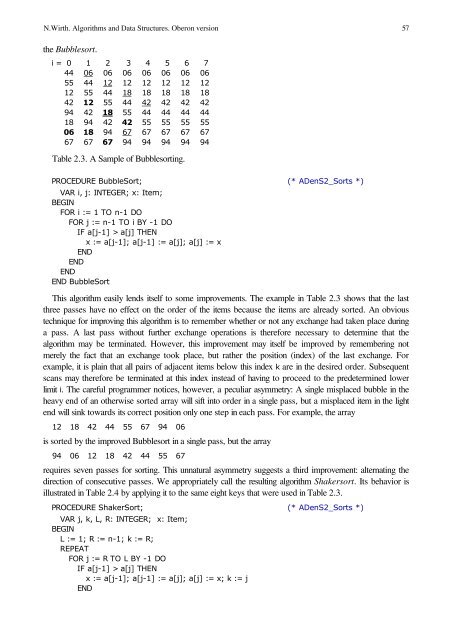Algorithms and Data Structures
Algorithms and Data Structures
Algorithms and Data Structures
You also want an ePaper? Increase the reach of your titles
YUMPU automatically turns print PDFs into web optimized ePapers that Google loves.
N.Wirth. <strong>Algorithms</strong> <strong>and</strong> <strong>Data</strong> <strong>Structures</strong>. Oberon version 57<br />
the Bubblesort.<br />
i = 0 1 2 3 4 5 6 7<br />
44 06 06 06 06 06 06 06<br />
55 44 12 12 12 12 12 12<br />
12 55 44 18 18 18 18 18<br />
42 12 55 44 42 42 42 42<br />
94 42 18 55 44 44 44 44<br />
18 94 42 42 55 55 55 55<br />
06 18 94 67 67 67 67 67<br />
67 67 67 94 94 94 94 94<br />
Table 2.3. A Sample of Bubblesorting.<br />
PROCEDURE BubbleSort; (* ADenS2_Sorts *)<br />
VAR i, j: INTEGER; x: Item;<br />
BEGIN<br />
FOR i := 1 TO n-1 DO<br />
FOR j := n-1 TO i BY -1 DO<br />
IF a[j-1] > a[j] THEN<br />
x := a[j-1]; a[j-1] := a[j]; a[j] := x<br />
END<br />
END<br />
END<br />
END BubbleSort<br />
This algorithm easily lends itself to some improvements. The example in Table 2.3 shows that the last<br />
three passes have no effect on the order of the items because the items are already sorted. An obvious<br />
technique for improving this algorithm is to remember whether or not any exchange had taken place during<br />
a pass. A last pass without further exchange operations is therefore necessary to determine that the<br />
algorithm may be terminated. However, this improvement may itself be improved by remembering not<br />
merely the fact that an exchange took place, but rather the position (index) of the last exchange. For<br />
example, it is plain that all pairs of adjacent items below this index k are in the desired order. Subsequent<br />
scans may therefore be terminated at this index instead of having to proceed to the predetermined lower<br />
limit i. The careful programmer notices, however, a peculiar asymmetry: A single misplaced bubble in the<br />
heavy end of an otherwise sorted array will sift into order in a single pass, but a misplaced item in the light<br />
end will sink towards its correct position only one step in each pass. For example, the array<br />
12 18 42 44 55 67 94 06<br />
is sorted by the improved Bubblesort in a single pass, but the array<br />
94 06 12 18 42 44 55 67<br />
requires seven passes for sorting. This unnatural asymmetry suggests a third improvement: alternating the<br />
direction of consecutive passes. We appropriately call the resulting algorithm Shakersort. Its behavior is<br />
illustrated in Table 2.4 by applying it to the same eight keys that were used in Table 2.3.<br />
PROCEDURE ShakerSort; (* ADenS2_Sorts *)<br />
VAR j, k, L, R: INTEGER; x: Item;<br />
BEGIN<br />
L := 1; R := n-1; k := R;<br />
REPEAT<br />
FOR j := R TO L BY -1 DO<br />
IF a[j-1] > a[j] THEN<br />
x := a[j-1]; a[j-1] := a[j]; a[j] := x; k := j<br />
END
















